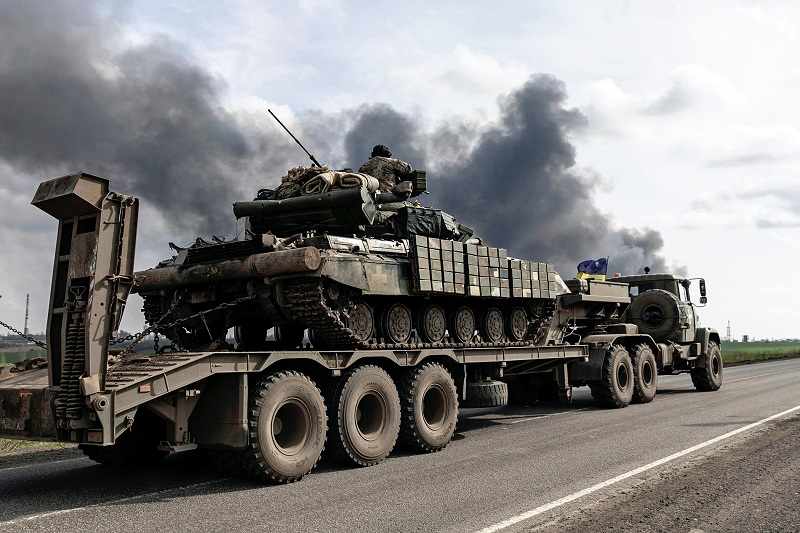
A Ukrainian soldier sits atop a tank in the Luhansk region of eastern Ukraine on Saturday.
7:00 JST, April 22, 2022
LONDON — The United States and European nations have expanded their military assistance to Ukraine, including a range of larger, more powerful weapons and equipment to combat and defend against the Russian invasion. Moscow’s military operation has moved to a new phase in which its forces are concentrated in eastern Ukraine and are attempting to capture and control the Donbas region. For Ukraine’s military, every second counts as it prepares for an all-out ground war.
In early April, images shared on social media appeared to show Polish Soviet-era T-72 tanks and other equipment being transported toward Ukraine. At around this time, Poland had signed a deal with the United States to acquire 250 technologically advanced U.S.-made M1 Abrams tanks.
The Polish government has not released details about this acquisition. However, in addition to the purchase of cutting-edge U.S. tanks, the deal raised the possibility that Poland had quietly supplied Ukraine with T-72s — armored fighting vehicles its military is adept at operating. If so, Poland would be the second nation after the Czech Republic to have delivered tanks to Ukraine.
After a video conference with allies and partner nations Tuesday, U.S. President Joe Biden indicated an intention to provide additional weapons to Ukraine. The U.S. Defense Department also revealed that day that “another nation” had supplied parts and equipment that enabled Ukraine to increase its fleet of fixed-wing aircraft.
The U.S. and European weaponry supplied to Ukraine initially were mostly antitank weapons and ground-to-air missiles intended firstly for defending the capital, Kyiv, from Russian forces. These nations limited their military support to an extent that could justifiably be called “weapons for self-defense,” and they resisted supplying large weapons that might excessively antagonize Russia. However, this approach changed in early April, with supplies of more offensive weapons announced since then. The United States plans to send unmanned attack drones and multipurpose helicopters, and Britain will deliver anti-ship missiles.
A race against time
The battle in eastern Ukraine will very likely determine that nation’s fate.
Russian forces initially attempted to capture Kyiv, but they withdrew after meeting fierce resistance from Ukraine’s military and have since been repositioned. Moscow’s strategy now centers on the eastern part of Ukraine, where it is preparing to enlarge the area that pro-Russian militant groups control in Donetsk and Luhansk provinces and then launch a full-scale offensive to control the entire Donbas region. Russia’s military is already gradually expanding the areas it occupies, so moves to strengthen Ukraine’s military capabilities are a “race against time.”
Recapturing territory seized by Russian forces will not be easy for Ukraine’s military. Controlling the Donbas region would give Russia an advantageous card to play in any ceasefire negotiations.
Hit-and-run tactics are effective in urban areas, but mobility will be essential for military units on the mostly flat, open terrain in eastern Ukraine. In response to Ukrainian requests, the United States and Britain will provide heavy weapons, such as artillery, and armored vehicles capable of traveling long distances.
Simmering discontent
In a recent report, the Atlantic Council, a U.S. think tank, predicted the campaign in which both militaries clash head-on for control of the Donbas is likely to become a “bloody war of attrition.” Ukraine’s concern that fierce fighting could drag on prompted calls to Western nations for supplies of artillery, armored vehicles, tanks, multiple-launch rocket systems and other equipment. Ukraine even specified the models of certain weapons it wanted.
However, only some of this equipment has been delivered, which has sparked strong disappointment on the Ukrainian side. Mykhailo Podolyak, adviser to the head of the Office of the President of Ukraine, could not contain his frustration in a Twitter post on April 17. Podolyak tweeted that Europe was giving Ukraine weapons, but “not the ones we asked for,” and added that weapons were taking “too long to arrive.”
"World" POPULAR ARTICLE
-

8 Japanese Nationals Stranded on Indonesia’s Sumatra Island
-

Mozambican Cooking Class Held in Matsuyama, Ehime Pref.; Participants Don Aprons, Bandanas Made from Traditional Mozambique Fabric
-

China to Impose Sanctions on Shigeru Iwasaki, Former Head of Japan’s Self-Defense Forces, Who Serves as Adviser to Taiwan’s Executive Branch
-

China Steps Up ‘Wolf Warrior’ Diplomacy Against Japan, Hurling Accusation About Plutonium Stockpile
-

U.S. Senate Resolution Backs Japan, Condemns China’s Pressure
JN ACCESS RANKING
-

Keidanren Chairman Yoshinobu Tsutsui Visits Kashiwazaki-Kariwa Nuclear Power Plant; Inspects New Emergency Safety System
-

Imports of Rare Earths from China Facing Delays, May Be Caused by Deterioration of Japan-China Relations
-

University of Tokyo Professor Discusses Japanese Economic Security in Interview Ahead of Forum
-

Japan Pulls out of Vietnam Nuclear Project, Complicating Hanoi’s Power Plans
-

Govt Aims to Expand NISA Program Lineup, Abolish Age Restriction
























